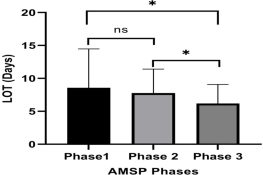
ABSTRACT
Background
Amid the pressing global concern of Antimicrobial Resistance (AMR), where Antimicrobial Stewardship (AMS) stands as a promising solution in relation to this, critical priority has been assigned to AMR pathogens in the Indian Pathogen Priority List to steer research focused on antibiotic-resistant bacteria. The study’s particular objective is to assess how an AMS intervention affects these pathogens in adult patients.
Materials and Methods
Over a dedicated two-year period from January 2021 to November 2022 research focused on adult patients harboring critical priority pathogens, adhering to ICMR directives. The primary goal was to comprehend antimicrobial drug usage in hospital’s medicine and surgery unit. Employing a qualitative approach, study conducted a Prospective Audit with Feedback (PAF), implementing deliberate constraints on antimicrobial drug usage to gain insights.
Results
The analysis encompassed 314 participants: 96 in control phase, and 115 and 103 in the intervention phases 2 and 3. Comparable demographics and service scope existed between intervention and control groups. All arms exhibited the presence of culture-positive organisms from the critical priority pathogen list defined by ICMR. Impressively, length of therapy per 1000 patient days notably dropped from 908.50 to 758.33 (p=0.001) post-intervention.
Conclusion
The study’s conclusion highlights responsible antimicrobial use in a tertiary care setting, showcasing promising progress. Noteworthy impacts on the dependent variable (Log_LOT) emerged across study phases, emphasizing intervention significance. Statistically significant Ward and Phase variables further enriched the overall insights.
